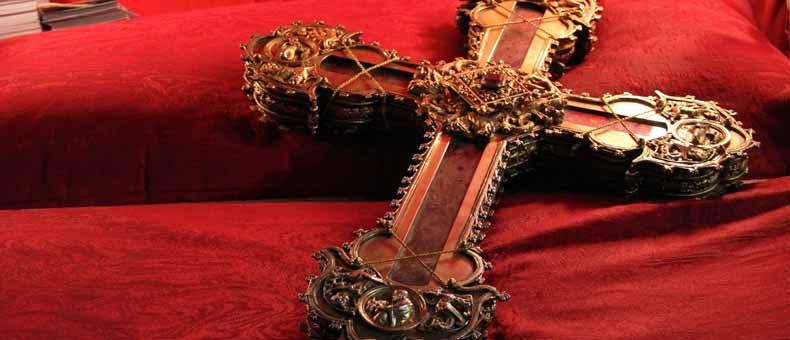Stage 1: EL Haya de Ontón- Castro Urdiales (21kM) through Cantabria
This stage pass through: Baltezana, Otañes, Santullán and Sámano.
The route is comfortable, it has restaurant services, fountains, rest areas all the way long and it is not very uneven.
We emphasize on the a Roman mile indicator in the square of ontañes that indicates the distance between Pisoraca (Herrera de Pisuerga) and Flavióbriga (Castro-Urdiales), the green route Castro-Traslaviña of 11 kms which is a nice walk by the old train rails, with rest areas, shadows and fountains all the way long.
Finally the beautiful Casto-Urdiales. Once we arrived at Toki Eder, an observatory palace from the beginning of the 20th century, we have to choose between walking by the promenade or through the official route, that means, the old fishing houses, which are narrow in front and deep, built like this, because tax was paid by windows. Today is a wine and tapas area. Castro is a Villa (town) with remarkable buildings, some moderns and others medievals , such as the Church of Santa Maria, Castillo-faro and the Hermitage of Santa Ana.
The Church of Santa María, looks like a Cathedral and is one of the few examples of Norman Gothic constructions in Cantabria (more adorned than the Castellan Cathedrals that raise the praise for God-Love Father who unites us and differs from the one of Santo Toribio de Liébana , austere that invites to the withdrawal in God-Love that inhabits us.
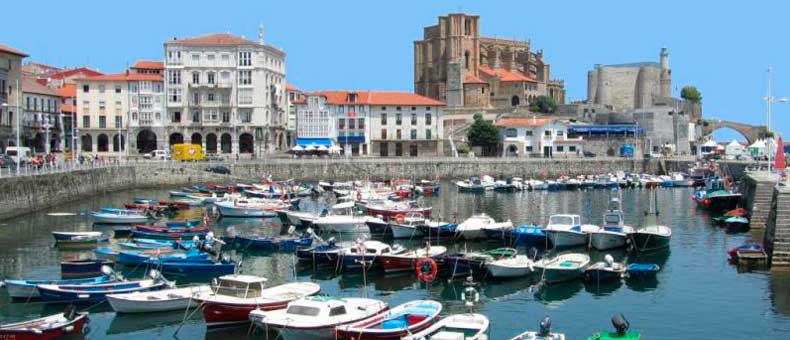
Stage 2. Castro Urdiales-Guriezo (12.9Km)
It is a short stage. Something that we appreciate, taking into account that it is worth spending some time visiting the Gothic Church of Santa Maria, as it is more beautiful, if possible, inside than outside. After the visit, we have the option of going directly to Liendo or even, for the more trained, to get to Laredo. If we sleep in Guriezo, we can avoid the climb to Nocina and follow the general road, with lot of caution, because there is a lot of traffic.
Today, in 13 kilometers, we will pass through the towns of Allendelagua, Cérdigo, Islares and Nocina.
The beautiful section that goes from the cemetery of Cérdigo and Islares passes first among holm oaks to pass to the cliffs. There are remains of a Pilgrims Hospital. The remaining three kilometers we go by a road with traffic but with beautiful views of the Cantabrian Sea.
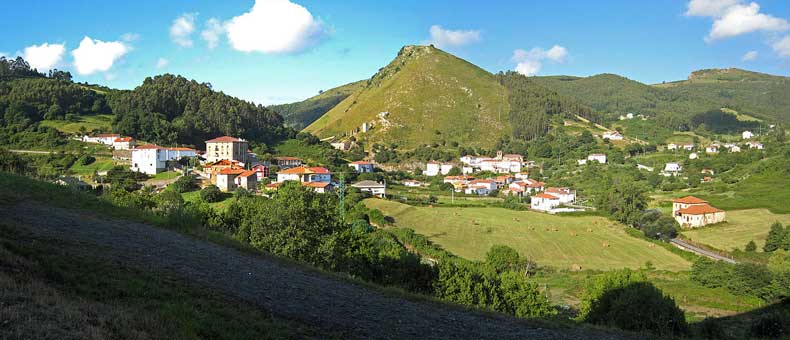
Stage 3. Guriezo-Laredo-Colindres (23.1kms-27.8Kms)
This stage starts from Guriezo and continues to Laredo, from Laredo, if there is a boat we can continue along the beach and approach the fourth stage Laredo-Güemes by Santoña.
However, if there is no boat (normally from early December until Easter), we can choose to go to Colindres. And from there begin the Fourth Stage.
In both cases, to get to Liendo we have to pass through Rioseco, Tresagua, Lugarejos, Iseca Nueva, Sopeña, and on the way to Laredo by Iseca Vieja, Las Cárcobas and Valverde.
The most remarkable aspect of the stage is the walk through the mountain before you can see the valley of Liendo, the wonderful image around the beach of San Julian between Liendo and Laredo, with its stones, memory of medieval and modern history of the Villa.
Standing out the two examples of Church, the Planta Salón or columnarias that are located in the beautiful Rioseco and in Liendo, just before arriving at the shelter. These churches have common characteristics: entrance altarpiece, columns that reaches the crosses in the equal hight vaults, leaving three ships diaphanous. They were constructed in the coastline municipalities of Cantabria at the beginning of the XVI, and get spread in Spain during the Renaissance and the Baroque eras.
We enter the Old town of Laredo, like all the pilgrims and merchants have done before through the Gate of San Martin, one of the three gates that the villa of Laredo still preserve and which is a few meters away from the Church of Santa María de la Asunción, a jewel of early Cantabrian Gothic era with some newly additions.
Also to be emphasized in Laredo, the houses of the villa nobles with their Baroque shields of arms and the XVI town hall building, with the statue of Carlos V at the entrance in memoria of his entrance to Spain through the port of Castro, before being crowned King of Spain.
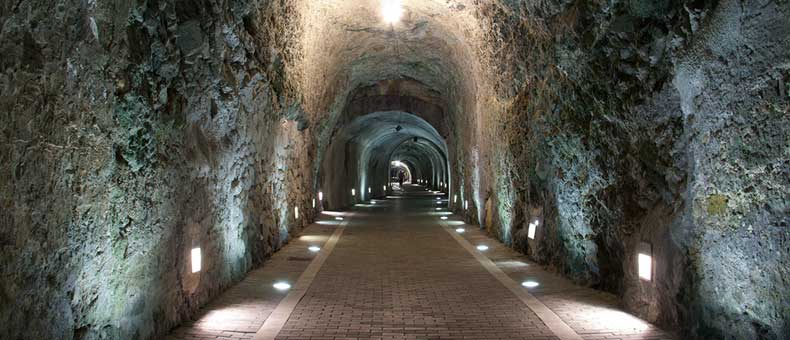
Stage 4. Laredo-Güemes
Maritime stage (36.3Kms)
The Fourth Stage of the North Road starts from Laredo and ends at Güemes. Now, as we explained at the end of the previous stage, there are three options for starting the stage depending on where we finished the day before.
FIRST CHOICE: if we stay in Colindres: we will see Camino del Norte Stage 4. Laredo – Güemes (terrestrial).
SECOND CHOICE: if we finish in Laredo and there is no boat to cross to Santoña, we will see Camino del Norte Stage 4. Laredo – Güemes (terrestrial).
THIRD CHOICE: if we stay in Laredo and there is a boat to cross to Santoña, ¡¡¡we will start!!!
The localities that accompany our steps today are: Santoña, Argoños, Helgueras, Noja, Soano, Isla, Bareyo, Meruelo and Güemes.
From Laredo, we will arrive at the sixteenth century city hall building and then we encourage to walk along the beach of the Salvé of more than 4 km, to catch the boat to Santoña.
Santoña below of Monte Buciero, with its marsh, and a mandatory stop in the Church of the XIII of Santa Maria del Puerto, with traces of transition to Gothic and what remains of some of the monasteries with more influence of the Medieval in Cantabria. We head to the beach of Berria and we cut through the Brusco, the almost architectural beauty of the rocks in the beach of Tregandín that takes us to Noja. Getting to Noja by Helgueras is for purists, the ideal choice.
Noja, with constructions of value and all services, precedes Soano where it worths having a walk next to the Natural Park of the Marshes of Santoña, Victoria and Joyel. Later from the church of Isla where the old hospital of pilgrims is, we will have a beautiful view of this site.
When we reach Bareyo, we will stop to rest below the church, a jewel of Romanesque art in Cantabria.
Terrestrial stage (44.8kms)
From Laredo to Argoños, which is the stretch of land that we have to walk if we do not take the boat to Santoña and therefore, we have not described. We will do it now:
The localities that we pass are those that surrounds part of the Natural Park of the Marshes of Santoña, Vicoria and Joel: Colindres, Treto, Cicero, Gama and Escalante.
The main difference between this terrestrial section and others is its cultural value. As we will find different Baroque Casonas palaces with an imposing entrance , chapel, shield and tower attached to the Casona and the monumental churches, with baroque altarpieces that workshops here have made it for the rest of the Spanish geography.
Also outstanding the old Bridge of Treto, which shows one of the exponents of the XIX Iron architecture designed by the same architect of the Eiffel tower.
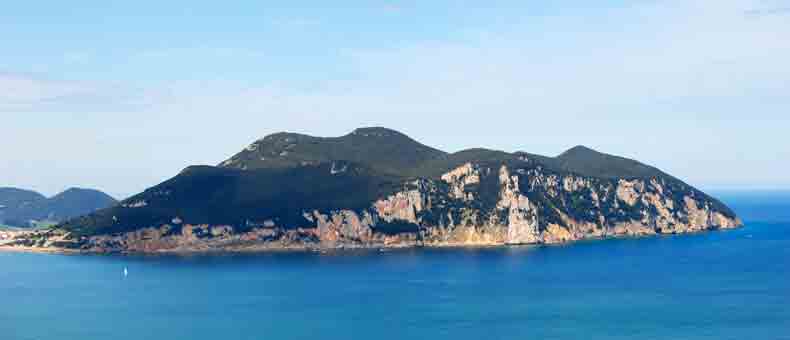
Stage 5. Güemes-Santander (18kms)
Short stage that gives us the possibility to know more deeply the capital of Cantabria. It is interesting to see the Cantabrian Bay that accompanies us all the way long, inside, in the Maritime Museum of the Cantabrian Bay, with its aquariums and sections dedicated to ethnography history and marine biology.
We have the option of avoiding the straight line Galizano-Somo by following a path along the coast. Pilgrims who wants to pray in temple or lovers of art, we must deviate to enter the Church of Galizano or Our “Señora de Latas”, both baroque buildings worthy of mention.
Localities of this stage are: Galizano, Somo, Pedreña and Santander.
From Güemes to Santander we go down to the road that goes to Galizano and we find an alternative to the official route to make the path to the coast. The road to Santiago runs along the main road, along the bike path. When arriving at Somo, we take the boat to the center of the city. This boat trip by the bay of Santander does not leave us indifferent, since from the peninsula of Magdalena to Pedreña we can see the whole center of Santander and Paseo de Reina Victoria. We walk through the Jardines de Pereda and from behind the post office we arrived at the Cathedral, under it the Church of the Christ where we obtain the credentials of both, the Camino de Santiago and the Camino Lebaniego.
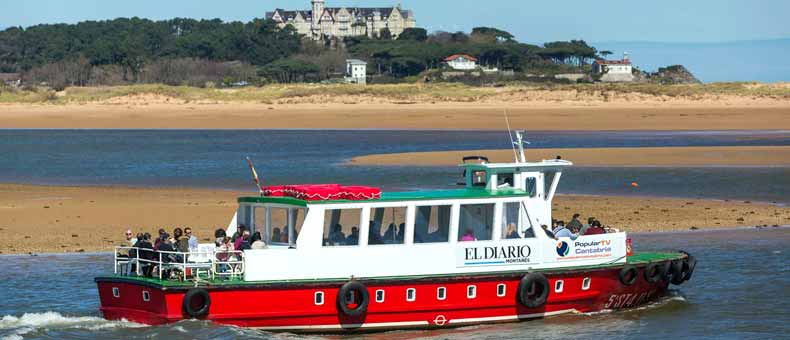
Stage 6. Santander-Santillana del Mar (40.6Kms)
It is a very long stage that can be divided. Ideal for cycling if you have not shortened the stage the previous day through Bezana.
The localities through which we pass from Santander to Santillana del Mar are: Peñacastillo, Santa Cruz de Bezana, Puente Arce, Requejada, Barreda and Queveda.
The most remarkable from the cultural point of view is, the bridge of the sixteenth century Arce and Santillana del Mar a medieval museum in itself.
We start from the center of Santander, to the right of the city council building or old San Francisco convent, then we walk through the center of the city in pedestrian streets like Burgos street and the beautiful Alameda.
In Puente Arce; at the shore of the river you can rest or enter one of the bars and have a snack. The pipes of Solvay, lead us to Requejada, with shelter. After a walk through Barreda and Camplengo to Santillana del Mar, we are transported to other times between stones. First of all, in front, the side of the Collegiate, the greatest exponent of the Romanesque in Cantabria and to the right the palace of Velarde. Other notable buildings are: The Towers of Merino and Don Borja, Casas del Águila and La Parra, the Palace and the Tower of Velarde, the House of Leonor de la Vega, Palaces Barreda, Tagle, Villa and a long etcetera.
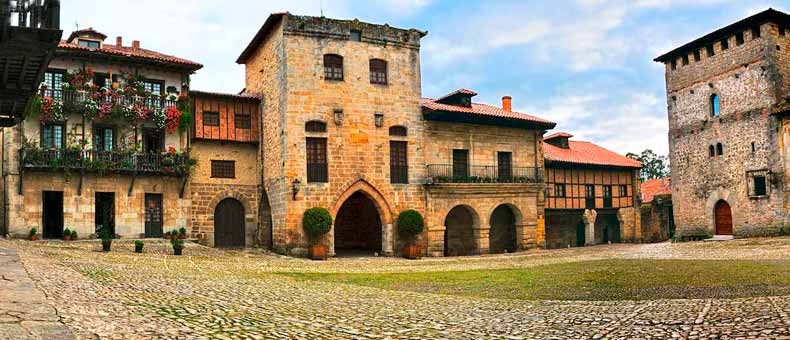
Stage 7. Santillana del Mar-Comillas (24.6Kms)
This is a beautiful stage like the previous stage can be divided into two. One part to Cóbreces and another to Comillas. The reason we make this recommendation is because of the importance of both sets. So we would have time to stay longer and fully enjoy them.
Santillana del Mar is a museum in itself. We have buildings of all historical epochs since the Middle Ages and also a few kilometers away, are allocated the universally known Caves of Altamira (Cuevas de Altamira), Sistine Chapel of the Quaternary
To get to Comillas, we go through: Arroyo, Oreña, Caborredondo, San Martin de Cigüenza, Cóbreces, Trasierra, Liandres, La Iglesia and Concha.
The core of this stage is the landscape itself, San Martín de Cigüenza with its magnificent Church of the XVI iron style, Cobreces with two equally remarkable temples, the beach of Luaña which we cross, the Monastery of the Discalced Carmelites where we can participate in the prayers and with luck accommodation, also the rows of Casonas de Concha.
Comillas, also called “The Villa of the Archbishops” or “La Villa de los Arzobispos”, because between the XVII and XVIII centuries, five prelates are born from here, also it stands out for the quality and quantity of works from the end of the XIX.
The relations that the first Marquis of Comillas Don Antonio López y López and his son Claudio López Bru had with the Catalan Modernism is evident in the stones of this stately Villa.
Notable examples are the Palace of Sobrellano (1881-1990) and the Chapel of the Pantheon (1881), Caprice of Gaudí (1883), Santo Hospital (1888), La fuente de los tres Caños (1899), the Monument to the Marquis (1890), and the Pontifical University. They work in them Joan Martorell, Cristóbal Cascante and Colom, Luis Domenech i Montaner and Antoni Gaudí.
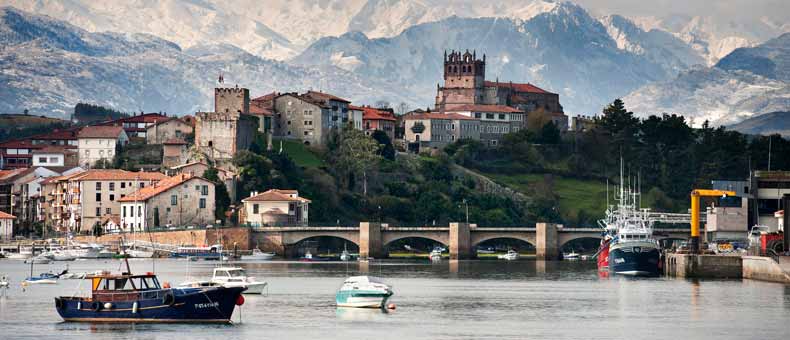
Stage 8. Comillas-San Vicente (12.2Kms)
From Comillas to San Vicente de la Barquera, the most remarkable are the two Villas and the landscape next to the Cantabrian Sea, which unites them.
Rubárcena, La Rabia, Guerra, Rupuente and La Braña is the route to follow at this stage.
As we pointed out at the end of the previous stage, Comillas is a practical class of what Modernism brings to Universal Art and we leave it behind in favor of the Natural Park of Oyambre and dreamy beaches.
Between one Villa and another, we walk almost all the time next to the Cantabrian Sea, Either by the walk, or we go down to the beach, as many pilgrims do.
You will begin to see in San Vicente the majestic Roman Vindios Mountains, that is called Picos de Europa, under which is an end of pilgrimage: Santo Toribio de Liébana and the Lignun Crucis. This Monastery is a springboard to the French Way if you wish to continue to Santiago de Compostela along the Vadinian Route from Santo Toribio to Mansilla de Las Mulas in León passing through Fuente Dé, Pandetrave and Riaño.
Returning to the North Road, Puente de la Maza welcomes us to San Vicente de la Barquera, as well as its Hermanas Villas de la Costa (Castro, Laredo and Santander which we have previously passed trough), by means of the Fuero of Alfonso VIII around 1200 d.c., was endowed with Castle, Church and Walls besides other privileges. St. Vincent preserves the Church and Castle intact and both of them can be visited.
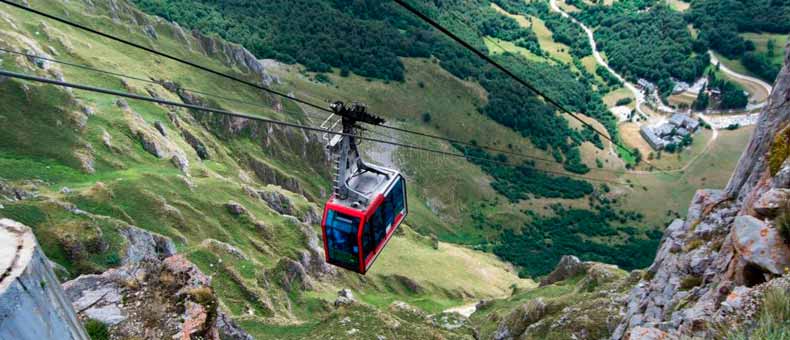
Stage 9.San Vicente-Unquera (16.4Kms)
From San Vicente de la Barquera to Unquera, we can divert in Muñorodero if we want, to make the Lebaniego Way, either as an end of pilgrimage in Santo Toribio or as a footbridge to the French Way, through the Vadinian Route that goes from Fuente Dé to Mansilla de las Mulas in Leon.
Again, following the Northern Way, from the landscape point of view we must recognize that before arriving at La Acebosa, we cannot resist looking at each instant back and contemplate the Villa de San Vicente immersed in its estuary. No less impressive are the Majestic Peaks of Europe (Picos de Europa), in which we will enter in a few days. Where ever you look, forwards or backwards, what surrounds us is spectacular.
At this stage we pass through La Acebosa, Hortigal, Estrada, Serdio and Pesués.
The most monumental of the stage along with San Vicente de la Barquera, with Church, Castle Rest of Wall, Casonas and Medieval Bridge, the Tower of Estrada and the one of Cabanzón are the patented memories that the Average Age has left in our step .
Once we arrive to Unquera, although not by the official route, we are still in time to pass by the Gorge(defile) of the Hermida, until Liébana in bus. To walk to Santo Toribio is more secure the Lebaniego Way since it is very well signposted, there is no traffic and there are shelters.
If not, we have deviated towards Liébana, in the next stage we are already in Asturias. From Unquera to Llanes, we expect 25 kms, although less distance we can find shelters from Colombres to 2 kms and in Buelna to 5 kms.
